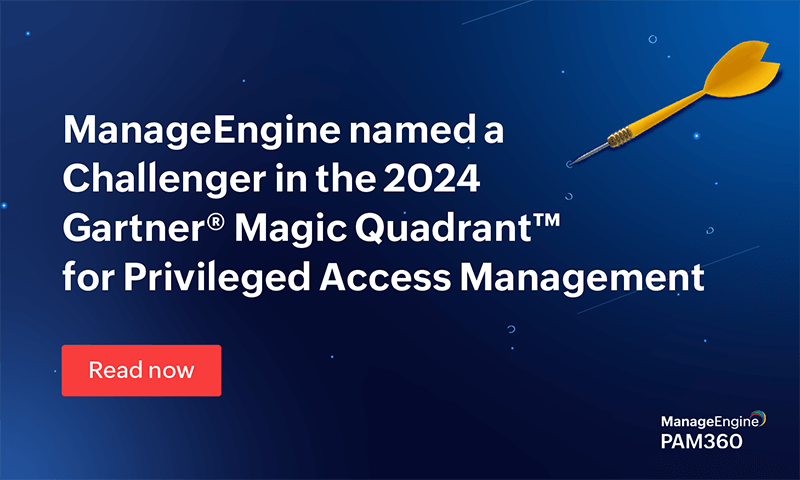What is privileged identity management (PIM)?
Privileged identity management (PIM) is a part of privileged access management (PAM) process. PIM involves a set of security controls to monitor, control, and audit access to privileged enterprise identities including service accounts, database accounts, passwords, SSH keys, digital signatures, and so on. By implementing a strong PIM strategy, enterprises can mitigate the security risks posed by privilege abuse.
PIM solutions are specifically designed to help IT teams enforce granular controls and provide strict governance over their privilege identities, which in turn aids in preventing insider threats and abuse of user privileges.
The difference between IAM, PIM, and PAM
In the broader scheme of things, both PIM and PAM are subsets of identity and access management (IAM), which deals with monitoring, securing, and managing enterprise identities. However, when it comes to securing and managing privileged identities, PAM and PIM play a vital role. To understand the distinction better, let's define each of these concepts:
IAM—IAM is a security framework that consists of special policies, controls, and solutions to facilitate the management of digital enterprise identities. IT managers leverage an IAM strategy to control access to databases, assets, networks, applications, and resources within their organization.
PAM—PAM, a class of IAM, deals with building an access control framework to protect, manage, monitor, and control privileged access pathways and activities across the enterprise.
PIM—PIM, a subclass of PAM, includes essential security controls and policies to manage and secure privileged identities, such as service accounts, usernames, passwords, SSH keys, digital certificates, and so on, which provide access to sensitive information.
To put it in perspective, IAM covers the broader access patterns across the enterprise verticals, encompassing all users, systems, resources and assets. PIM and PAM, on the the hand, cover access patterns surrounding privileged resources and systems.
Why is privileged identity management important for enterprises?
These days, enterprise IT departments face the challenge of providing granular access to corporate resources. There is a lack of contextual information about users and requesters of data, which is a significant factor to consider before granting data privileges.
Privileged identities are omnipresent in any IT environment. IT admins, privileged users, third-party contractors, vendors, engineering teams—everyone needs access to privileged accounts and credentials to perform business sensitive operations. However, higher privileges come with greater security risks, if these identities are not secured with an appropriate access control strategy. Lax management of privileged identities could present an ideal opportunity for attacks to break into an organization's security perimeters and navigate through business sensitive information without leaving any trace. Further, if IT teams do not have a track-record of what their employees are doing with their privileges, or how privileged accounts are being used, any malicious insider can exploit their privileges and compromise business data for personal gains.
The success of any business depends on the privacy and accuracy of the data it processes. Therefore, managing and controlling access to data and enterprise assets should be paramount for any organisation. Likewise, to avoid any penalties or lawsuits due to data breaches, organisations must ensure a streamlined workflow when it comes to authenticating access to their data.
That being said, privileged identity management (PIM) solutions are designed to centralize, control, track and secure access to privileged accounts and identities. This will give IT teams complete control and visibility over their privileged assets, resources and identities. PIM tools can also provide actionable insights for staying compliant with regulatory standards.
Top benefits of implementing a privileged identity management solution
1 Complete control and visibility
Take control of your privileged accounts and identities by storing them in an encrypted digital vault secured with multi-factor authentication.
2 Improved security posture
Reduce the threat vectors down to zero, and help effectively battle the growing risks of external attacks, identity theft, and insider threats.
3 Data-driven incident response
Enforce security controls to detect and prevent suspicious user activities and privileged account misuse through real-time user activity audits and comprehensive reports.
4 Eliminate standing privileges
Purge the risks associated with standing privileges, such as identifying and removing orphaned or inactive accounts. Enable role-based access controls and approval workflows for granular sharing of credentials.
5 Seamless compliance to industry regulations
Comply with industry and government standards and regulations, such as HIPAA, PCI DSS, GDPR, NERC-CIP, SOX and more.
Best practices for effective privileged identity management

Discover and vault a list of privileged identities, such as passwords, SSH keys, digital certificates, in a secure, fortified online repository. Auto-update the list whenever new identities are added/created.

Enforce stringent policies such as periodic password resets, time- and role-based access to privileged resources, automatic reset of credentials upon one-time use, and other security controls.

Implement least-privilege controls by granting privileged access to non-admin users and third-parties with minimal and just about enough privileges to carry out their activities.

Monitor and audit privileged access activities and remote sessions in real-time to identify malicious users, and make informed security decisions.
How to choose the right privileged identity management (PIM) solution for your organization
Given that privileged identity management is a part of privileged access management (PAM), organizations should consider implementing a strong PAM solution, which encapsulates the inherent use cases of PIM alongside including other core PAM controls, such as privileged session management, secure remote access, privileged user behaviour analytics (PUBA), machine identity management, application credential security, just-in-time privilege elevation, and so on.
ManageEngine PAM360 is a unified privileged access management solution for enterprises. It enables IT administrators and privileged users to gain granular and complete control over critical IT resources, such as passwords, digital signatures and certificates, license keys, documents, images, service accounts, and more.
PAM360 includes contextual integrations with SIEM, ticketing and analytics solutions to help IT teams build user behaviour models to identify and terminate anomalous activities, generate comprehensive audits and compliance reports, and take data-driven security decisions.
Fortify access to your enterprise identities, and improve your privileged access security posture with PAM360.

